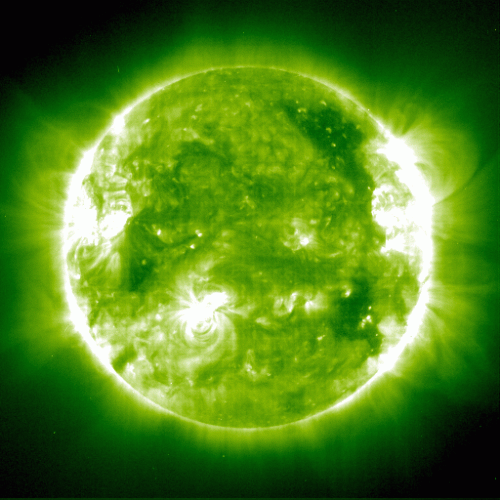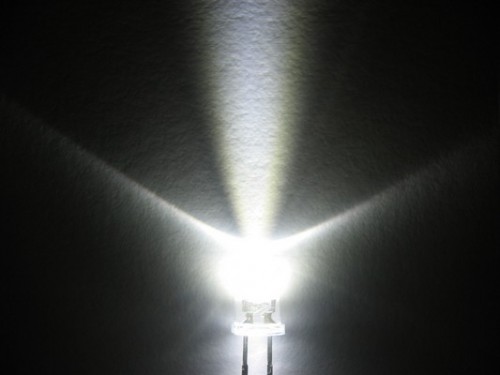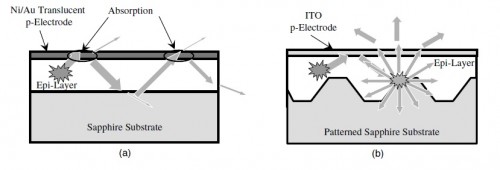New and Improved: White LED Lights
It’s hard to compete with the luminous output of a ball of hydrogen and helium gas 864300 miles in diameter, but it should be noted that sunlight is not without its drawbacks. It’s nearly impossible to use at night, and the quality of light is affected by everything from cloud cover to latitude. Fire works indoors and at night for light, but it’s not very bright, often rather smoky, and could potentially rage out of control and destroy one’s house. Incandescent light bulbs use too much electricity and put out a kind of yellow or light that doesn’t render color the way sunlight can. They also burn out with irritating rapidity. And don’t get me started on fluorescents or sodium halide.
Image courtesy http://coolcosmos.ipac.caltech.edu
The solution these days is to use LED bulbs. They’re adorably tiny, use very little electricity, and they last for ages. The problem has been that individual LED’s don’t put out enough light to compete with standard light bulbs for everyday interior/exterior use by people living in homes and working in offices. Researchers from the Nichia Corporation in Tokushima, Japan have developed a white LED that with “a luminous flux of 1913 lumens and a luminous efficacy of 135 lumens per watt at 1 amp – [can] emit more light than a typical 20-watt fluorescent bulb, as well as more light for a given amount of power. With these improvements, the researchers say that the new LED can replace traditional fluorescent bulbs for all general lighting applications, and also be used for automobile headlights and LCD backlighting” (Zyga).
Image courtesy crunchgear.com
The researchers focused on how luminous the lights appeared as perceived by the human eye (luminous flux), as well as how luminous they were given a certain amount of power (luminous efficacy). They fabricated three types of white LEDs, “each of which utilized a variety of improvements in device structure to improve their luminosity, or brightness, and reduce their operating voltage” (Zyga). All of the white LEDs were based on blue LED dies, each coated with a yellow phosphor to widen the emission spectrum. The blue light emitted from the LED die mixes with the yellow fluorescence from the phosphor to produce white light. Red phosphor was also added to balance the spectra (Zyga). The resulting LEDs produce whiter light at lower voltage than ever before.
“The cross-sectional structure of (a) a conventional LED and (b) a new high efficacy LED with the patterned sapphire substrate and ITO contact as p-type electrode, which reduce the optical absorption and improve the extraction efficiency. Credit: Yuko Narukawa, et al.” Via: Physorg.com
The design improvements point to a world where solid-state lighting replaces our everyday light bulbs. Although the new white LEDs are more expensive than others on the market today (natch) the price can only come down as economies of scale kick in.
I’m filing white LEDs under FIRE, similar to another post I wrote about LEDs that emit green light (which I hope you’ll check out at your leisure).
Cited:
Zyga, Lisa. “White LEDs with Super-high Luminous Efficacy Could Satisfy All General Lighting Needs.” Physorg.com 08/31/10. Accessed 09/02/10. URL.
More:
Yukio Narukawa, et al. “White light emitting diodes with super-high luminous efficacy.”J. Phys. D: Appl. Phys. 43 (2010) 354002 (6pp). DOI:10.1088/0022-3727/43/35/354002


















Now LED bulbs with cool packaging. http://lovelypackage.com/gauss-led/
[…] in many display panels and street lights on the road. A lot of light emitting diode, especially white light emitting diode, uses phosphor powder to stimulate light of different wavelengths. However, phosphor powder is […]
[…] 6. Materials that emit light efficiently: White LED Lights […]
Leave a Wordpress Comment:
Ads
Watch ARCHITERIALS Videos on vimeo
Like on Facebook
Twitter
Flickr
Hit Counter
Ads
Blogs
Green
Journals/Publications
Materials
Network/News
Offices/People
Resources
Science
Pages
Archive
RSS and Email Subscriptions
Tag Cloud
3D 3D printer AB FAB academic acid acrylic actuated matter adaptive adhesive adsorption aerogel air air conditioning alloy aluminum amnh antibacterial antifungal ants april fool's architecture architecture robot artificial skin autonomous aviation awesome bacteria bamboo bananas beer bench bend bending biennale biocomputing biodegradable biodegradeable biomaterials biomimetics biomimicry biominerals biopolymer birds blast blast-resistant block blocks blogs Bloom Box brazil brick bubbles bucky bulk metallic glass butterfly calera canvas carbon carbon fiber carbon nanotubes carpet cars ceiling cellulose cement ceramic chain link chair charcoal charlie sheen chemicals chiller clay cloth cloud cmu coils color color-changing communication compound computer concrete condensation conducting conductive context cool coral cracks crystal cyborg demakersvan design digifab dirt disaster dna dror drywall dutch dynamic EAP earth ecocradle ecolect e coli ecology ecoresin ecovative elastic electric electricity electrochromic electroluminescent electronic energy energy recovery environment evaporative cooling experiment fabric fabrication facade fiber fiberglass fiber optic fiber optics fibers film FIRE flexible flickr fly ash foam fungus furniture garbage gel geodesic dome geometry gfrp gilgamesh glass glass fiber glow glue gold graphene green greensulate gsapp gypsum hard heat heavy heidi klum helix hemp hexagon hidden high performance hive honeybee humidity ice India ink insulation interference Internet inventables invisible invisible ink jello jellyfish just add water kevlar kinetic korea lace lamboo laser lattice leaves LED leed LEGO light light emitting light transmitting liquid lo mein london Loop.pH machines magic magnetic marine material materials meatball melting memory metabolic engineering METAL metal panel metamaterial micro microsensor microtools military milk MIT moisture multi-layer mushrooms mycelium nano nanogel nanotech nanotubes NASA new noise non-metallic oil OLED OMA ostrich oysters packaging paint panel panels paper paperfoam paraffin wax particles particulates petroleum phase change phosphorescent pink PLA plastic platinum pm-10 poetry pollution polymer polymers porcelain power precast printed printing protein public quadror radiant rain rammed earth reclaimed recycled reflective refracting Rem Koolhaas resin robot robotics roof rubber rugged sand sealant sealer search segmented self-healing sensor shape memory silica silicon silk skin skittles slats smog soft solar solar cell solar cells solar paint solid solid state lighting sound spider spider glue spray stabilized sand stone stretch stretchable strong structural structure studio dror sun sunglasses super supercritical sustainable switzerland tags tape technology TED tensile TEXAS textile textiles texture thermal thermochromatic thin thin film thread tiger stone tile tiles timber tio2 tires toaster tokujin yoshioka touch touch-sensitive toxic transparent t shirts tulip ultra-thin university of akron university of connecticut upcycling virus voc wall wallpaper WATER web wet whale wires WOOD woodwool wool workshop
WP Cumulus Flash tag cloud by Roy Tanck and Luke Morton requires Flash Player 9 or better.
Recent Comments
Ads
Recent Posts
Most Commented
Most Viewed